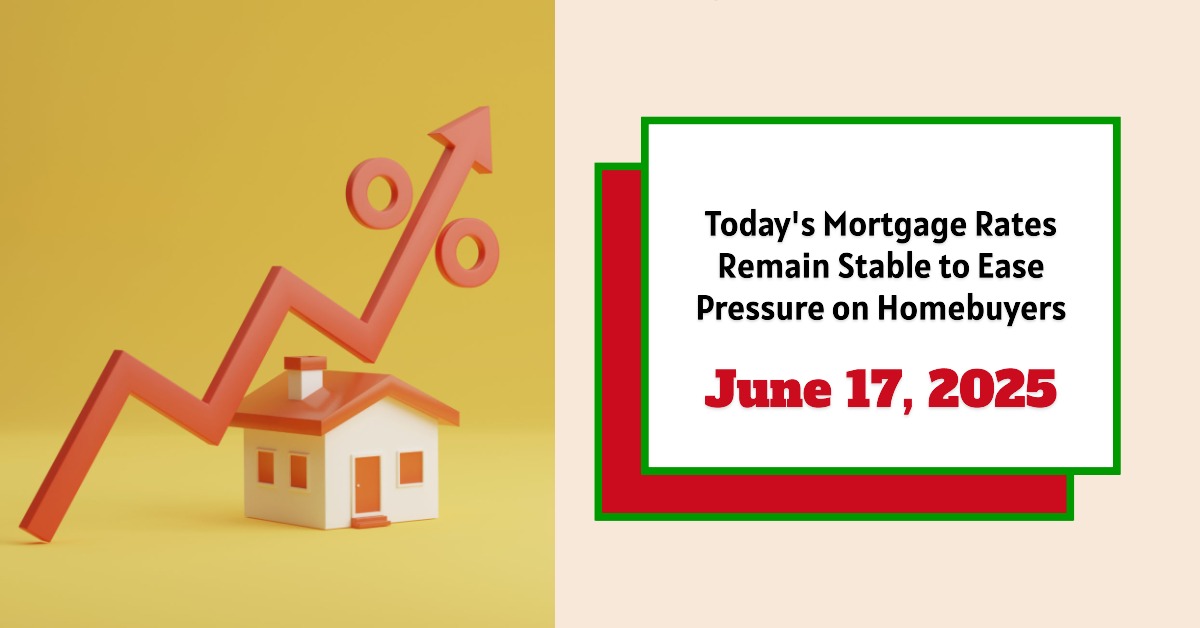As of June 17, 2025, mortgage rates have remained stable, with the current average 30-year fixed mortgage rate at 6.93%. This rate shows no change from the previous week, indicating a period of stability in the housing finance market. Additionally, the average 15-year fixed mortgage rate remains steady at 6.01%. In contrast, the 5-year adjustable-rate mortgage (ARM) has decreased, moving from 7.39% to 7.01%. This stability in rates reflects a mixture of factors, including economic conditions and the Federal Reserve's ongoing monetary policies.
Today's Mortgage Rates – June 17, 2025: Stable Rates Ease Pressure on Homebuyers
Current market conditions reflect a cautious optimism. Experts do not expect an interest rate cut from the Federal Reserve anytime soon, which indicates that mortgage rates will likely stay in this tight range for the foreseeable future. Despite this stability, homebuyers should not make decisions based solely on market fluctuations; they are better off focusing on improving their credit scores and seeking lenders with competitive fees.
Key Takeaways:
- Current 30-Year Fixed Mortgage Rate: 6.93%
- 15-Year Fixed Rate: Steady at 6.01%
- 5-Year ARM Rate: Decreased to 7.01%
- 30-Year Fixed Refinance Rate: Decreased to 7.17%
- Interest Rate Stability: Current market conditions and Federal Reserve decisions impact future trends.
Understanding Current Mortgage Rates
Mortgage rates are crucial for anyone considering homeownership or refinancing existing mortgages. Various factors influence these rates, including economic indicators, inflation, and the actions of the Federal Reserve. With today’s rates being stable, it provides an opportunity for potential homebuyers to assess their options without the pressure of rising costs.
According to recent data from Zillow, the national average 30-year fixed mortgage rate stands at 6.93%, unchanged from last week. When securing a 30-year fixed mortgage, this rate means you would pay 6.93% interest over the life of the loan. For a shorter-term option, the 15-year fixed mortgage rate remains stable at 6.01%, appealing for buyers looking to pay off their loans faster.
For adjustable-rate mortgages, the 5-year ARM rate has decreased to 7.01%, making it a more attractive option for those expecting to either sell or refinance within five years. This substantial drop of 38 basis points can lead to lower initial payments compared to fixed-rate loans.
Current Mortgage Rates Comparison Table
| Loan Type | Current Rate | 1 Week Change | APR | 1 Week Change |
|---|---|---|---|---|
| 30-Year Fixed | 6.93% | +0.00% | 7.38% | -0.01% |
| 20-Year Fixed | 6.58% | +0.09% | 6.91% | +0.00% |
| 15-Year Fixed | 6.01% | +0.00% | 6.30% | -0.01% |
| 10-Year Fixed | 5.87% | -0.13% | 6.23% | -0.04% |
| 7-Year ARM | 7.63% | +0.30% | 8.09% | +0.17% |
| 5-Year ARM | 7.01% | -0.32% | 7.59% | -0.27% |
| 3-Year ARM | N/A | N/A | N/A | N/A |
The above table shows how various mortgage products are tracking this week. The 30-year fixed rate continues to be popular among buyers looking for long-term stability, while the ARMs are drawing attention due to their lower initial costs.
Current Refinance Rates
For those looking to refinance, the national average 30-year fixed refinance rate has indeed fallen from 7.21% to 7.17%. This slight drop presents an opportunity for existing homeowners to potentially lower their mortgage payments.
| Refinance Program | Current Rate | 1 Week Change | APR | 1 Week Change |
|---|---|---|---|---|
| 30-Year Fixed | 6.93% | +0.00% | 7.38% | -0.01% |
| 20-Year Fixed | 6.58% | +0.09% | 6.91% | +0.00% |
| 15-Year Fixed | 6.01% | +0.00% | 6.30% | -0.01% |
| 10-Year Fixed | 5.87% | -0.13% | 6.23% | -0.04% |
| 5-Year ARM | 7.00% | +0.00% | 7.30% | +0.00% |
This decrease in refinance rates could help homeowners reduce their monthly obligations or tap into their home equity more affordably. However, potential refinancers must ensure that their overall financial circumstances align with such options.
Exploring Other Mortgage Options
In addition to fixed-rate loans, various mortgage options cater to different financial situations and risk profiles. Understanding these options can help potential homeowners make informed decisions based on their personal circumstances.
1. Government Loans
Government-backed loans are fantastic options, especially for first-time homebuyers or those with lower credit scores:
- FHA Loans: The 30-year fixed rate for FHA loans is currently 7.42%, a rise of 0.59% from last week. These loans help low-to-moderate-income buyers secure a home with lower down payment requirements.
- VA Loans: The 30-year fixed VA loan is at 6.52%, an increase of 0.11%. VA loans are a strong option for military veterans and active duty members, providing favorable terms such as no down payment and no private mortgage insurance (PMI).
- USDA Loans: Available for low-to-moderate income borrowers, typically in rural areas, USDA loans can offer competitive rates and favorable terms. Specific rates were not highlighted this week, but they often parallel FHA loan offerings.
2. Adjustable-Rate Mortgages (ARMs)
Adjustable-rate mortgages (ARMs) can be appealing due to their initial lower rates when compared to fixed-rate mortgages. The current 5-year ARM rate at 7.01% provides an attractive starting point for buyers looking to stay in their homes for a shorter period, although borrowers should be cautious of potential rate increases at subsequent adjustments.
3. Interest-Only Mortgages
Another option available is an interest-only mortgage. Borrowers pay only the interest for a specified time before repaying the principal. While the initial payments can be lower, it’s important to recognize the risk of payment increases once the interest-only period is over.
Related Topics:
Mortgage Rates Trends as of June 16, 2025
The Federal Reserve's Role in Mortgage Rates
The Federal Reserve plays a crucial role in determining mortgage rates. Currently, experts do not anticipate the Fed to cut rates in the foreseeable future. The combination of recent economic developments and the prevailing inflation concerns suggests that the rates affecting borrowers might remain stable or even potentially rise.
Over recent years, mortgage rates have been directly influenced by the Fed's monetary policy decisions. When the Fed raises its benchmark interest rates, the cost of borrowing tends to increase, leading to higher mortgage rates. Conversely, when rates are kept low, mortgage rates also tend to ease.
In 2024, the Fed reduced its rates which led to a dip in mortgage costs initially. However, as the economic landscape has stabilized, these cuts have not continued, leading banks to keep mortgage rates steady.
Impact of Federal Reserve's Decisions on Mortgage Rates
If the Federal Reserve maintains current interest rates, analysts predict that mortgage rates will likely remain steady. However, a potential increase in rates can lead to higher borrowing costs for homeowners, ultimately affecting affordability and decreasing demand in the housing market.
Should unexpected economic shifts force the Fed to lower rates, mortgage rates could similarly fall, creating a more favorable environment for buying or refinancing homes. Ultimately, economic indicators should continually be monitored by borrowers.
Will Mortgage Rates Finally Drop?
Due to persistent inflation and economic uncertainty, the trajectory of mortgage rates remains closely tied to Federal Reserve policy decisions in its upcoming meetings. The stability observed now may be indicative of a more prolonged period of holding steady or marginal increases, rather than dramatic decreases, throughout the rest of 2025.
The Broader Impact of Mortgage Rates on the Economy
Mortgage rates have wider implications on the economy than one might expect. High mortgage rates can suppress housing demand, slowing sales and negatively impacting home construction and renovation sectors. A decrease in purchasing power can affect broader consumer spending, impacting local and national economies.
Conversely, lower mortgage rates can stimulate home buying, driving up economic activity. Homeowners may feel more comfortable making home improvements or purchasing new furniture, which can inject money into various market sectors.
Final Thoughts:
Navigating the world of mortgages can feel overwhelming, especially with the varied options available. As of June 17, 2025, the stability in mortgage rates, particularly the 30-year fixed rate at 6.93%, provides a sigh of relief for prospective homebuyers. The existing stable market conditions yield an environment conducive to planning, and individuals can make informed choices without pressure from fluctuating rates.
Gaining an understanding of the current mortgage market, various loan types, and Federal Reserve policies is essential for prospective buyers and refinancing homeowners alike. Staying informed will ensure that individuals can secure favorable financing options that align with their financial goals.
Invest Smarter in a High-Rate Environment
With mortgage rates remaining elevated this year, it's more important than ever to focus on cash-flowing investment properties in strong rental markets.
Norada helps investors like you identify turnkey real estate deals that deliver predictable returns—even when borrowing costs are high.
HOT NEW LISTINGS JUST ADDED!
Connect with a Norada investment counselor today (No Obligation):
(800) 611-3060
Also Read:
- Will Mortgage Rates Go Down in 2025: Morgan Stanley's Forecast
- Expect High Mortgage Rates Until 2026: Fannie Mae's 2-Year Forecast
- Mortgage Rate Predictions 2025 from 4 Leading Housing Experts
- Mortgage Rates Forecast for the Next 3 Years: 2025 to 2027
- 30-Year Mortgage Rate Forecast for the Next 5 Years
- 15-Year Mortgage Rate Forecast for the Next 5 Years
- Why Are Mortgage Rates Going Up in 2025: Will Rates Drop?
- Why Are Mortgage Rates So High and Predictions for 2025
- Will Mortgage Rates Ever Be 3% Again in the Future?
- Mortgage Rates Predictions for Next 2 Years
- Mortgage Rate Predictions for Next 5 Years
- Mortgage Rate Predictions: Why 2% and 3% Rates are Out of Reach
- How Lower Mortgage Rates Can Save You Thousands?
- How to Get a Low Mortgage Interest Rate?
- Will Mortgage Rates Ever Be 4% Again?



